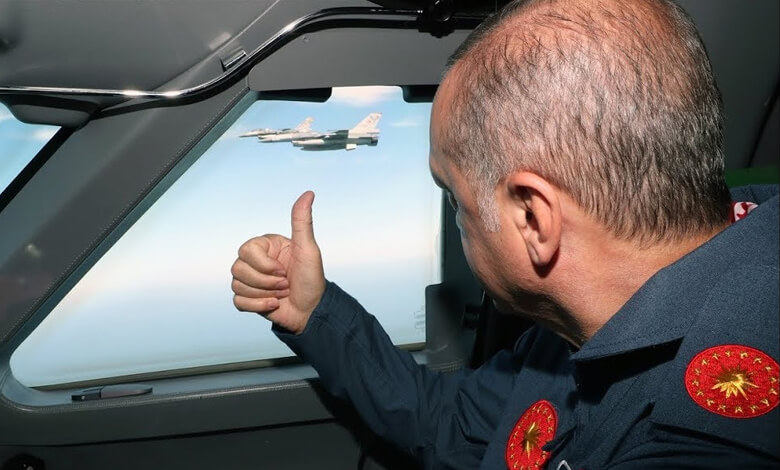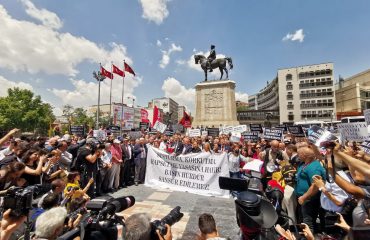

“We have S-400s, we don’t have F-35s, and we are ready to spend a fortune to strengthen our existing F-16s, while grappling with an economic crisis. We are awaiting news from the U.S., as President Erdoğan put it, possibly obtaining F-35s for Greece in the meantime.” President Erdoğan salutes the F-16s accompanying him on his way to attend the Teknofest exhibition. (Photo: Presidency)
After President Tayyip Erdoğan signed and sent the approval for Sweden’s NATO membership to the Turkish Parliament, U.S. President Joe Biden also notified Congress for the sale of 40 F-16 fighter jets and 79 upgrade kits to Türkiye for $23 billion. A 15-day process has commenced. To prevent the opposition in Congress from blocking the sale, the U.S. administration included a notification to sell 40 F-35 fighter jets to Greece for $8.6 billion.
Apart from Türkiye agreeing to strengthen Greece’s air defense gap to address its own air defense gap, there is another noteworthy detail here: While Greece is asked for only $8.6 billion for 40 F-35 fighter jets (the world’s first and only truly 5th generation fighter aircraft), Türkiye is asked for 2.5 times that amount, $23 billion, for the same number of (4th generation) F-16s and 79 upgrade kits.
Those F-35s were supposed to be Türkiye’s
However, back on June 21, 2018, when Türkiye received the first aircraft of the 100 F-35s at the facilities of the designer and main manufacturer Lockheed-Martin in Texas, it would pay only 11 billion dollars; the possibility of Greece purchasing F-35s was not even on the table. Türkiye had not yet been in an economic crisis, while Greece was still in the effort to emerge from one.
According to strategic planning made in the second half of the 1990s, Türkiye had participated as a co-producer in the “future fighter aircraft” project, as decided by the Defense Industry Executive Committee on July 12, 2002. The other producing countries were the U.S., UK, Italy, Netherlands, Canada, Australia, Denmark, and Norway. Japan, South Korea, and Israel had already become buyers. Turkish companies, including TUSAŞ, Alp Aviation, Kale Group, and AYESAŞ, were to produce a total of 1005 F-35 parts in Türkiye, generating a volume of $7.5 billion for the Turkish defense industry and bringing new technology.
The first 6 F-35s were supposed to arrive at the 7th Main Jet Base Command in Malatya in November 2019, and pilot training was set to begin.
The good news Erdogan awaited
As of January 2024, Türkiye has no opportunity to acquire F-35s, and it will pay more for strengthening its F-16 fleet than Greece will for the F-35s it will own, despite efforts to overcome the economic crisis it is in.
Those who want to explain this situation with the construction of the National Combat Aircraft (MMU or TF-X) claim that F-16s will be sufficient until the MMU joins the fleet. However, there is little mention that having the F-35s and their technology in Türkiye would make the MMU project much easier to progress. Because reminding this would mean criticizing Türkiye for facing an economic crisis while also facing the risk of an air defense gap since 2018.
President Erdogan, who has been in power in this process under the Presidential Government System, stated on January 26 that the positive outcome from the U.S. would “initiate the process of sending F-16s to Türkiye, starting the process of repair and maintenance.” This was actually the first official acknowledgment, according to official records, that some of the 243 F-16s, which are officially active in the Turkish Air Force, could not perform their duties properly due to spare parts, repair, and maintenance problems due to the U.S. arms embargo.
How did we get into this situation?
After securing the strengthening of the Turkish Air Force fleet with the F-35 contract, it was time to strengthen Türkiye’s most significant gap, missile defense. The AKP government announced on September 26, 2013, that the bid had been awarded to the FT-2000 system manufactured by China’s CPMIEC. However, two problems arose. First, the Chinese company had been blacklisted by the U.S. in February 2013 due to its trade with Syria, Iran, and North Korea. Second, the FT-2000 was an upgraded version of Russia’s S-300 missiles; China planned to buy the more advanced S-400s it lost in the tender.
In October 2015, the U.S. and Germany withdrew the Patriot batteries stationed in Türkiye under NATO, which were deployed against the possibility of a missile attack at the beginning of the Syrian civil war; now the threat was not the Assad regime but ISIS. Relations with the U.S. were strained.
The Russia Crisis, July 15, and the S-400s
Then-Prime Minister Ahmet Davutoğlu announced on November 15, just before President Erdogan opened the G20 Summit in Antalya on November 15-16, that the China tender had been canceled. Less than ten days later, on November 24, Turkish F-16s shot down a Russian Su-24 jet violating the Syrian border. It was the first Russian aircraft shot down by a NATO member.
Relations with Russia entered a deep crisis. Efforts to reconcile began immediately; it was announced on June 29 that secret diplomacy had yielded results and the crisis was overcome. Two weeks later, on July 15, 2016, the attempted military coup shook all political balances. Erdogan saw the U.S., which hosted Fethullah Gülen, the alleged mastermind behind the coup attempt, as responsible for the crisis.
On the night of the coup, it was observed that Türkiye did not perceive the F-16s controlled by coup plotters as “enemies” using NATO standard Stinger missiles in its possession. However, this feature was present in Russian-made missiles seized from the PKK.
On December 27, 2017, an agreement worth $2.5 billion was announced with the Russian company Rosboronexport for 2 S-400 air defense systems.
Trump removes Türkiye from the F-35
The U.S. began to claim that both the F-35 and S-400s used artificial intelligence, learned from each other, and posed a threat to NATO defense. Congress was pressuring those trading with Russia in violation of the Countering America’s Adversaries Through Sanctions Act (CAATSA). Meanwhile, U.S. President Donald Trump began to threaten Türkiye for different reasons, such as the release of Pastor Andrew Brunson, who was imprisoned in connection with the events of July 15. After the message “I will ruin your economy” in 2018, the first currency crisis occurred.
U.S. Defense Secretary Mark Esper informed Turkish Defense Minister Hulusi Akar on June 6, 2019, that if the S-400s came to Türkiye, the joint production program of the F-35 would be suspended. President Erdogan declared on July 14 that there was no turning back from the S-400 purchase due to the F-35 threat, saying, “We are trying to guarantee peace and our own national security.”
The first S-400 battery was delivered to Ankara on July 12-15, 2019. On August 23, the U.S. withdrew its new Patriot offer to Türkiye. On August 27, the delivery of the second S-400 battery (to be completed on September 15) began. On August 28, Esper said, “Either F-35 or S-400s, not both”; the U.S. had removed Türkiye from the F-35 program.
The military devised the F-16 formula
The two aircraft Türkiye received in 2018, which were still held in Luke Air Base in Arizona, U.S., were not to be given. At this stage, the Ministry of National Defense raised the need to upgrade the F-16 fleet with the expectation of reclaiming the $1.4 billion paid for these aircraft. Although Türkiye has achieved success in the production of UAVs and UAVs in recent years, contributing to tactical defense, it cannot be a solution to a serious strategic defense gap that will arise within 10 years in the absence of F-35s. The participation of the National Combat Aircraft, named “Kaan,” as the primary force in the Turkish Air Force would go beyond 10 years.
On the other hand, rising anti-Türkiye sentiment in the U.S. Congress, fueled by the lobbies of Greece, Armenia, and Israel, also prevented approval for the sale of F-16s.
Russia’s attack on Ukraine in 2022 and Sweden and Finland’s desire to become NATO members led Erdogan to propose the “F-16 against Sweden in the face of NATO membership” formula to Biden to take precautions against the PKK.
The role of Defense Minister Güler
In this last process, Defense Minister Yaşar Güler’s two statements played an important role. In the middle of the Gaza Crisis, a day before Erdogan’s trip to Germany, and on November 16, 2022 the day the Foreign Affairs Commission of the Grand National Assembly postponed the Sweden vote, he brought up the issue of Eurofighter purchase. Thus, Güler emphasized that Türkiye needed a fighter jet to strengthen its strategic air defense and, if it could not be an F-16, it should still be NATO-compatible (for example, not Russian-made Su-35s). His message was also directed at NATO members and the U.S., naturally; the military was emphasizing that Türkiye needed to remain in NATO.
Several steps were needed to persuade the Greece lobby, which is a sympathizer of Biden. Erdogan had already stated that he would never meet with Greek Prime Minister Kyriakos Mitsotakis again, saying, “We can come unexpectedly one night,” but Mitsotakis, like Erdogan, had won the elections again.
Second statement and result
Erdogan went to Athens on December 7 and delivered the message, “We are both NATO members, allies.” Biden, in a phone call on December 14, opened his visit with “You pass Sweden through the Parliament, and I will pass the F-16 through Congress.” However, this message did not reach the Turkish public; it seemed as if only Gaza and Israel were discussed.
On December 16, Güler again mentioned Eurofighter; if it was not F-16, Germany should be convinced for Eurofighter.
On December 18, Erdogan announced Biden’s formula. With Erdogan giving the green light to the AKP Group on December 26, the decision on Sweden passed the Foreign Affairs Commission of the Grand National Assembly. The Ministry of Foreign Affairs, led by Hakan Fidan, convinced the MPs from the Nationalist Movement Party (MHP) who objected ; the Republican People’s Party (CHP) had already announced that it would vote positively.
Only the political risk Erdogan would take remained: What would happen if Sweden became a member with the decision of the Grand National Assembly, and Biden said, “Sorry, I tried, but it didn’t work,” and Erdogan found himself in the situation of Kenan Evren after the September 12 coup?
Blinken came for this formula
The main reason for U.S. Secretary of State Antony Blinken’s visit to Istanbul on January 5 and then to Athens was not Gaza and Israel, but this.
The inclusion of the sale of F-16s to Türkiye in the same package as the sale of F-35s to Greece has now been finalized. In other words, those who wanted to prevent Türkiye by blocking Congress would have prevented Greece as well, in this way, both in an election year. The process, postponed by the PKK’s attack on January 12, was completed with the approval of Sweden’s membership in the Grand National Assembly on January 23, reaching 287 votes in favor and 55 against, and Erdogan’s signature, delivered to the U.S.
Two S-400s scenarios
If Türkiye had not bought the S-400s, F-35s would have joined the Turkish Air Force since March 2019. The arrival of the F-35s would not have hindered Türkiye from developing its own UAVs, starting the MMU project, accelerating the construction of its own warships, and not being an obstacle to the Altay tank projects. On the contrary, it could have accelerated them. If the conditions for the Patriots were not suitable instead of the S-400s, the NATO-compatible SAMP-T system, which is still on hold and awaiting technology transfer, joint production, and (now already in use) was possible.
We have S-400s, we don’t have F-35s, and we are ready to spend a fortune to strengthen our existing F-16s. While grappling with an economic crisis, we are awaiting news from the U.S. as President Erdoğan put it, possibly obtaining F-35s for Greece in the meantime.
This will be an example to be taught in textbooks in the future.


